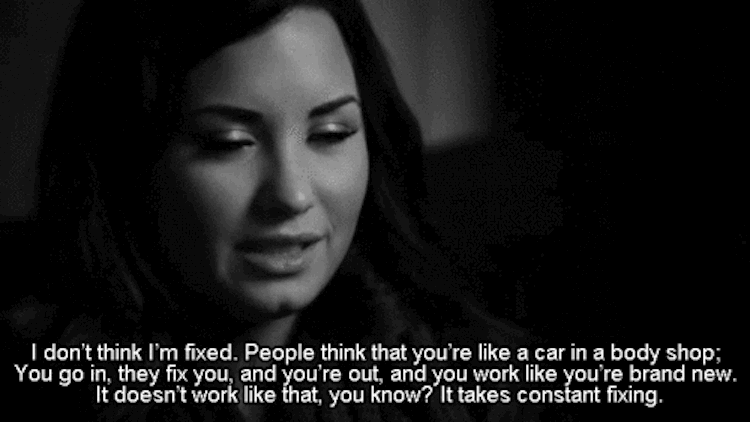The first residential eating disorder program opened in 1985, but the industry did not take off until recently. Due to changes in health care and growing awareness of the dangers of eating disorders, the amount of residential eating disorder clinics has tripled in the last decade.
With 75 programs across the country, these clinics are evidentially quite popular. However, the smiling faces on these clinics’ websites don’t tell the full story. Digging deeper into the world of eating disorder clinics reveals some alarming truths.
1. They have to make a profit.

GIF courtesy of Watitis23.tumblr.com
Unlike most hospital-based treatment programs, residential eating disorder clinics are owned by for-profit health care organizations. While this doesn’t mean earning money is a clinic’s only concern, it does mean it is a priority.
Because the clinics and the organizations that own them need to make money, the programs tend to be quite expensive. Residential programs cost anywhere from $500 to $2000 per day. Some experts also worry that these organizations are rushing to establish more and more profitable clinics and are sacrificing quality in the process.
“For the most part, the people who are running and working in these programs believe they’re doing the right thing,” said Dr. Angela Guarda, the director of Johns Hopkins Hospital’s eating disorders program. “But it’s a slippery slope. Money can cloud your view.”
2. Patients don’t always come first

GIF courtesy of Wifflegif.com
Any business that hopes to be successful must advertise, and as for-profit institutions, eating disorder clinics are no different. In an article that calls for eating disorder clinics to be more open about their financial relationships with clinicians, a group of experts explains how eating disorder clinics can abuse marketing techniques.
The clinics advertise themselves to the medical community to convince doctors to refer people to their program. They give out small gifts, like pens and bags, at professional eating disorder conferences and send staff to visit doctors, buy them lunch, and take them out for dinner.
Some programs even pay for doctors to take trips to their clinics and try their activities. Some therapists feel that these tours are like all-expense paid vacations.

GIF courtesy of gifs.tastefullyoffensive.com
Virginia psychologist Adrian Brown recalls a treatment center promised “We will pay your way, put you up in a really nice hotel, all expenses paid, yoga and whatever.” She declined the offer, which she viewed as “not ethical.”
However, other doctors feel these trips simply help them make more informed referrals. “It was actually really educational. They took us in depth into what they did” said Ann Smith, a Maryland Therapist who visited the Oliver-Pyatt eating disorders center.
Still, studies show that even the smallest of gifts can affect how doctors make prescriptions and referrals. The article explains that the effect of these marketing techniques “may not be fully recognized by the professionals they target.”
Because of these marketing techniques, doctors may refer patients to an eating disorder clinic for all the wrong reasons. Right now, patients cannot be fully confident that their doctor recommends an eating disorder clinic because they believe it is the best treatment.
3. There’s no science behind them.

GIF courtesy of reddit.com
The programs’ websites will bombard you with statistics about treatment effectiveness, weight gain, and recovery, but most clinics actually collect very little of their own numbers. They usually borrow treatment descriptions and data from hospital-based treatment facilities.
Eating Disorder clinics have to do this because there is little research about the effectiveness of their programs. According to the aforementioned article, “Programs vary substantially in quality, and peer-reviewed evaluations of program efficacy are scant.”

GIF courtesy of giphy.com
It can be difficult to study these programs because they vary so widely. The industry has yet to regulate quality and treatment methods, so every program offers different types and levels of care. And no third-party is measuring how effective they actually are.
Most programs often both scientifically verified treatments, such as cognitive behavioral therapy, and unproven activity-focused therapies, such as horse riding, drama, and dance.What little research has been done on these clinics tends to lump all therapies together, so it tells us little about which aspects of these programs actually work.
4. They’re not always worth it.

Because of the lack of research on eating disorder clinics, we must rely on personal experiences and testimonials to determine their qualities. The NY Times conducted a series of interviews with former patients and discovered mixed results. Some patients felt the treatment centers weren’t worth the price.
“People were nice, and the food was really good,” said Melissa R., a former patient at a residential program in the Southwest. “I had fun, I enjoyed rock climbing and stuff, but that’s not why I was there. I’m paying a lot of money to get well, not to rock climb.”
Melissa later had more luck at an Eating Recovery Center in Denver, which she described as “very individualized” and “the best place.” But Ahsley Bilkie had a very different experience at ERC. Bilkie has tried four residential programs, including two stays at ERC, but her condition only worsened and worsened.

Photo by Jennifer Cao
While many patients enjoyed these resort-like clinics and found the relaxed atmosphere helps them to more easily recover from their eating disorder others felt it didn’t help them develop the tools to battle their eating disorders in the real world.
Some patients report that their illness returned quickly as soon as they left the safety of the program. “You’re going back into your life, you’re going back into all the emotions you used your eating disorder to hide from” said Tina Kalus, a former residential program patient.
5. They exist because we need them.

GIF courtesy of giphy.com
Did you know that eating disorders are the deadliest mental illness? And yet it can be very difficult for those struggling with an eating disorder to find the specialized help that they need. The scariest part about these treatment programs is how badly they are needed.
“Only 15 to 30 percent of people have access to specialized care for eating disorders, which means there are a lot of people out there who have zippo” said Doug Bunnell, the chief clinical officer for Monte Nido, a California-based residential program.
These residential programs provide much-needed treatment to people with the most severe eating disorder cases, but their financial decisions and treatment qualities need to be better monitored and regulated. Vulnerable patients struggling with an eating disorder deserve proper treatment, not to be taken advantage of.




